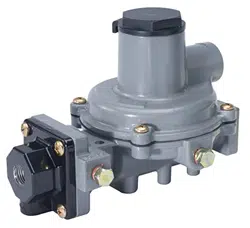Loading ...
Loading ...
Loading ...

R122H, R222H, R222, R232A and R232E Series
LP-Gas Regulators
7
Overpressure Protection
!
WARNING
Some type of overpressure protection is
needed if actual inlet pressure can exceed
the outlet pressure rating. Overpressuring
any portion of this equipment above the
limits shown in the Specications may
cause damage to regulator parts, leaks
in the regulator or personal injury due to
bursting of pressure-containing parts or
explosion of accumulated gas.
If any portion of the regulator is exposed
to an overpressure condition that exceeds
the limits in the Specications, it must
be inspected for damage that may
have occurred.
Large volumes of gas may discharge
through the regulator vent during internal
relief valve operation, which can, if not
controlled, result in re or explosion from
accumulated gas.
The R122H, R222H, R222, R232A and R232E Series
regulators, except for the rst
stage of the Types R232A
and R232E, contain internal relief valves. The internal
relief valve in all units will give overpressure protection
against excessive build-up resulting from seat leakage
due to worn parts or chips or foreign material on the
orice. The amount of internal relief protection provided
varies with the regulator type and the cause for the
overpressure relief valve operation, see Table 1. When
the internal relief valve opens, gas escapes to the
atmosphere through the regulator’s vent.
Some type of additional external overpressure
protection must be provided if the outlet pressure in an
overpressure condition exceeds the inlet pressure rating
of the gas system or downstream equipment. Common
methods of external overpressure protection include
relief valves, monitoring regulators, shutoff devices and
series regulation.
Maintenance
!
WARNING
To avoid personal injury or equipment
damage, do not attempt any maintenance
or disassembly without rst isolating
the regulator from system pressure and
relieving all internal pressure.
Regulators that have been disassembled
for repair must be tested for proper
operation before being returned to service.
Only parts manufactured by Fisher
®
should
be used for repairing Fisher regulators.
Relight pilot lights according to normal
startup procedures.
Due to normal wear or damage that
may occur from external sources,
these regulators must be inspected and
maintained periodically. The frequency
of inspection and replacement of the
regulators depends upon the severity of
service conditions or the requirements of
local, state and federal regulations. Even
under ideal conditions, these regulators
should be replaced after 20 years from
date of manufacture or sooner should
inspection reveal the need.
Visually inspect the regulator each time a
gas delivery is made for:
• Improper installation, vent not pointed vertically down or
under a cover; no vent tube on underground systems
• Plugged or frozen vent
• Wrong regulator or no regulator in the system
• Internal or external corrosion, including paint chipping
or aking
• Flooded Regulator; water in spring case; regulator
submersed on underground tanks
• Regulator age
• Any other condition that could cause the uncontrolled
escape of gas
Failure to do the above could result in personal injury or
property damage.
Vent Opening
Make sure the regulator vent, vent assembly or vent
tube does not become plugged by mud, insects, ice,
snow, paint, etc. The vent screen aids in keeping the vent
from becoming plugged and the screen should be clean
and properly installed. Make sure any irrigation system
operated near a regulator or vent line does not spray water
into the vent opening of the regulator or vent assembly.
Water inside Regulators from Floods,
Weather or Water Table on
Underground Systems
Replace any regulator that had water in their spring
case, has been ooded, has been submersed below the
water table of an underground tank or shows evidence
of external or internal corrosion. Checking for internal
Loading ...
